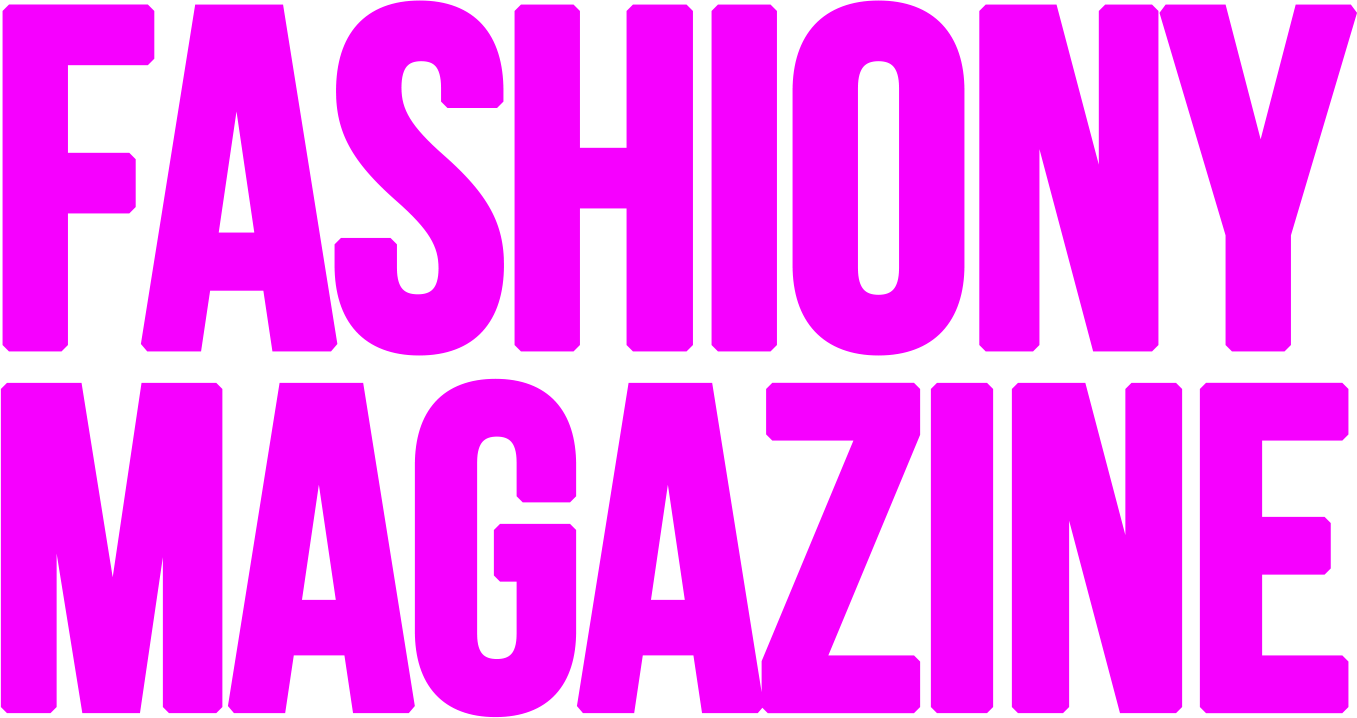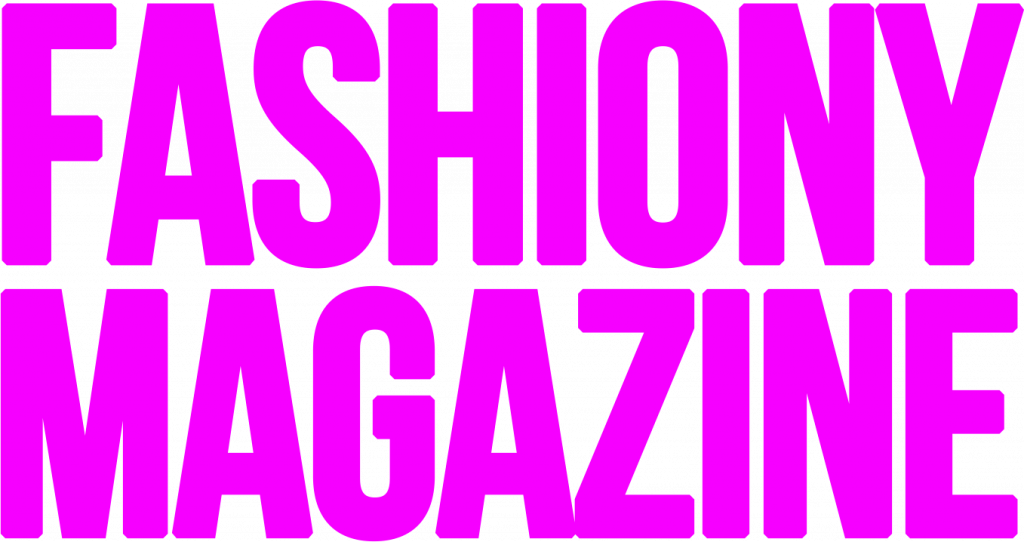Lorena Rae – Next Supermodel from Germany?
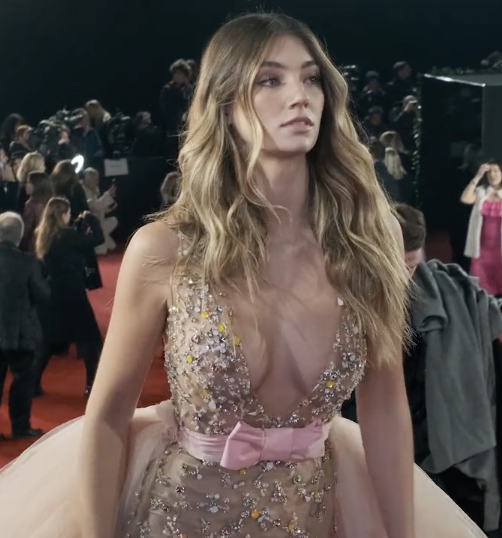
Lorena Rae, born on July 8, 1994, in Diepholz, Lower Saxony, Germany, has established herself as a renowned model and actress with a diverse career. With a height of 5 feet 11 inches and a slim build, Rae’s striking blue eyes and brunette hair have become her distinctive features. Early Life and Family Background: Rae grew up in Germany and is the eldest of three siblings, having a sister named Celine and a brother named Maurice. She holds both American and German nationality and identifies with Caucasian white ethnicity. Rae’s family background and early life, especially her parents‘ information, have not been extensively publicized. Educational Journey: For her education, Rae attended Berufs Gymnasium Wirtschaft and the Vocational Training Center Dr. Jürgen Ulderup. This educational background laid the foundation for her future endeavors in the fashion industry. Modeling Career: Rae’s modeling career began with the brand Bijou Brigitte, leading her to work in locations like Milan and Ibiza. A significant milestone in her career was signing with the Wilhelmina agency in 2015, which propelled her further into the limelight. She has worked with notable brands like L’Oréal, Hugo Boss, NewYorker, and Guess. One of her most significant achievements was walking in the Victoria’s Secret Fashion Show in 2018, a coveted role in the fashion industry. Acting and Other Ventures: Besides modeling, Rae has dabbled in acting, with her debut film role in ‚The Flower of Life‘ (2017). She has also appeared in television series like ‚Fashion Police‘ in 2016. Her net worth, as of the latest reports, is around $1 million, reflecting her success in both modeling and acting. Personal Life: Rae is known for her rumored relationship with actor Leonardo DiCaprio in 2017, which garnered significant media attention. She is currently in a relationship with CJ Jones. Rae’s personal interests include a love for dogs, adventure sports, and a preference for the American accent, influenced by shows like ‚The Vampire Diaries‘ and ‚Gossip Girl‘. Social Media Presence: Rae is active on social media platforms like Instagram, where she has a substantial following, showcasing her modeling work, personal life, and travels. In conclusion, Lorena Rae’s journey from a small town in Germany to international fame in modeling and acting is a testament to her talent and hard work. Her involvement with top brands, participation in prestigious fashion shows, and forays into acting highlight her versatility and appeal in the entertainment industry.
How to Eat a Cupcake Right: A Seriously Silly Guide
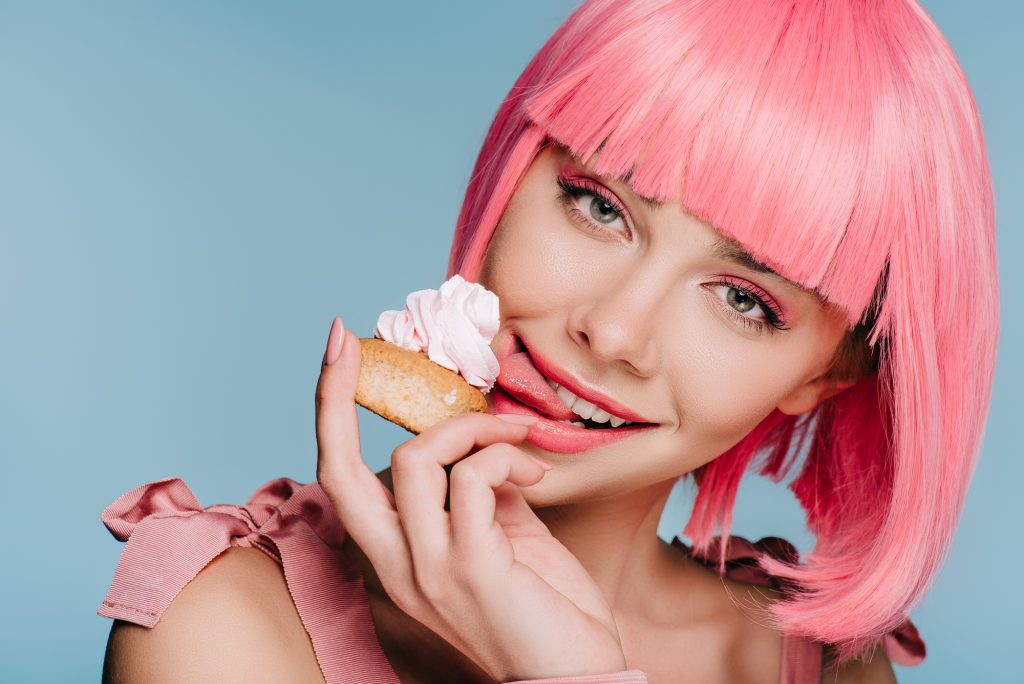
Welcome, dear readers, to the most critical culinary conundrum of our times: how does one properly consume a cupcake? Fear not, for we have undertaken extensive research (and taste tests) to bring you the definitive guide to cupcake consumption. Prepare your napkins, and let’s dive into this deliciously ironic exploration. Step 1: The Art of Selection First and foremost, choosing the right cupcake is crucial. Beware of those with too much frosting; they’re a trap for amateur eaters. Instead, opt for one with a modest frosting-to-cake ratio. Remember, you’re eating a cupcake, not a frosting cup. Step 2: The Dissection Once you’ve chosen your cupcake, it’s time for the dissection. Some might say, „Just bite into it!“ To those people, we say: amateur hour is over. The connoisseur’s approach is to gently separate the bottom half of the cupcake from the top. This isn’t just eating; it’s an operation. Step 3: The Frosting Sandwich Technique With your cupcake neatly bifurcated, flip the bottom half and place it on top of the frosting. Voila! You’ve just created a cupcake sandwich. This revolutionary technique ensures an even distribution of frosting with every bite, solving the age-old problem of too much cake at the end. Step 4: The Elegant Bite Now that you have your cupcake sandwich, it’s time for the main event. Approach with caution and take a bite with the grace of a ballet dancer and the precision of a surgeon. This is the moment of truth. If done right, you’ll experience the perfect cake-to-frosting ratio, a moment of pure bliss. Step 5: The Cleanup You thought we were done? Oh no, dear cupcake eater. The aftermath of cupcake consumption is as important as the act itself. Check for frosting on the face – a common rookie mistake. Use a napkin, not your sleeve. Remember, we’re civilized cupcake eaters. Conclusion: The Cupcake Connoisseur By following these steps, you’ll not only enjoy your cupcake to the fullest but also rise in the ranks of cupcake connoisseurs. So the next time you’re faced with a cupcake, remember this guide and eat with confidence. And to those who prefer the straightforward bite: we salute your simplicity but remind you that the world of cupcakes is one of complexity and elegance. In conclusion, eating a cupcake right is no mere child’s play; it’s an art, a science, and a journey of self-discovery. Happy eating!
Signs of Social Media Addiction: Do you realise anything?
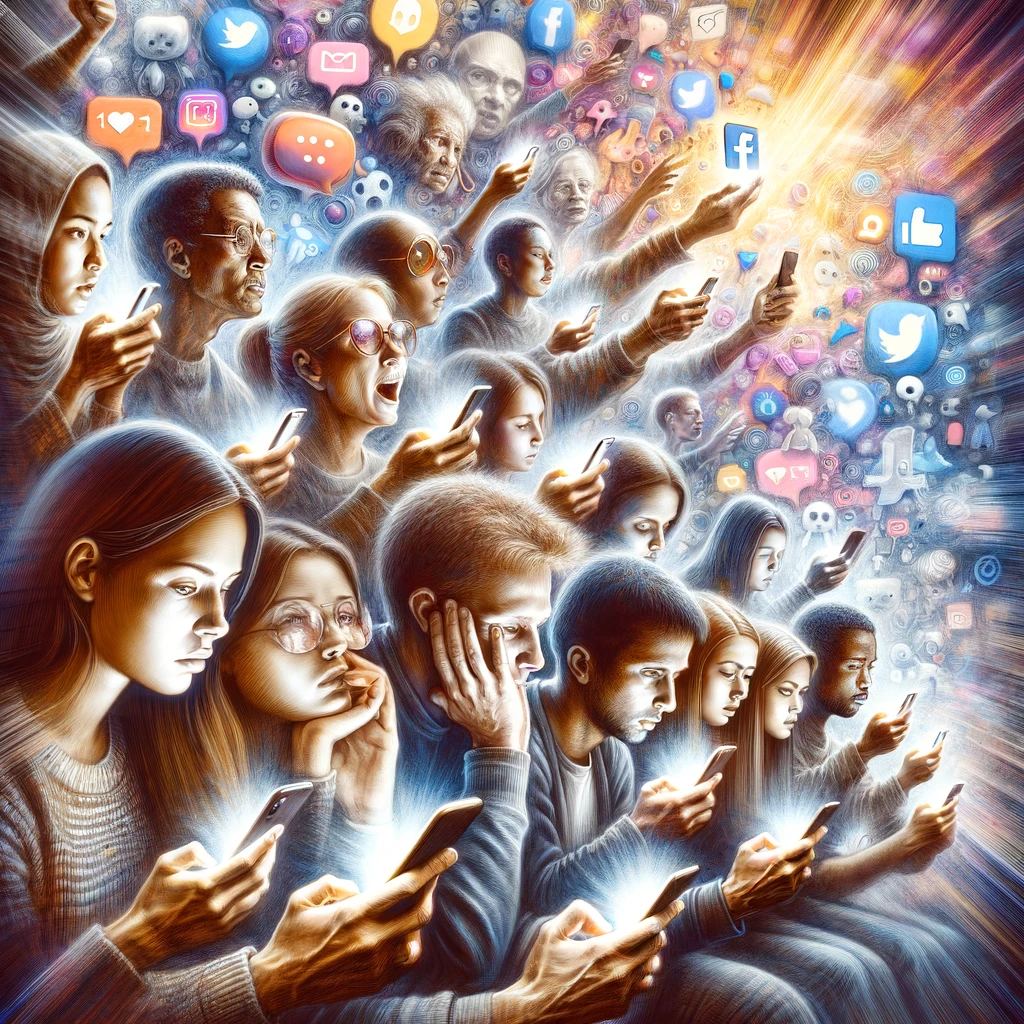
Signs of social media addiction can vary, but here are some common indicators: 1. Excessive Time on Social Media: Spending a significant portion of the day on social media platforms, often at the expense of other activities or responsibilities. 2. Neglect of Personal Life: Neglecting personal relationships, work, or studies due to the time spent on social media. 3. Mood Changes: Experiencing mood swings, irritability, or anxiety when not able to access social media. 4. Withdrawal Symptoms: Feeling restless, anxious, or uncomfortable when not using social media. 5. Over-Preoccupation with Social Media: Constantly thinking about social media even when not using it, or planning the next opportunity to log on. 6. Interference with Daily Activities: Allowing social media use to interfere with daily activities, such as eating, sleeping, or engaging in face-to-face interactions. 7. Decreased Physical Activity: A noticeable decrease in physical activity and increase in sedentary behavior due to time spent on social media. 8. Use as an Emotional Escape: Using social media as a means to escape from negative feelings or reality. 9. Impact on Mental Health: Experiencing negative impacts on mental health, such as increased feelings of loneliness, depression, or anxiety. 10. Ignoring Negative Consequences: Continuing to use social media despite being aware of its negative consequences on personal, social, or professional life. It’s important to note that these signs can also be indicative of other issues and not solely social media addiction. If someone is showing these signs and it’s impacting their life negatively, it may be helpful to seek professional advice. Scientific research Scientific research on social media addiction has been extensive, exploring various aspects such as its development, underlying causes, and impacts on well-being. Key findings from recent studies provide a multi-dimensional perspective on this phenomenon. One significant area of research focuses on the role of emotions, both positive and negative, in social media addiction. Positive emotions often drive ‚reward-seeking‘ behavior, where users chase the dopamine rush associated with social validation on these platforms. This can lead to increased engagement and prolonged usage. On the other hand, negative emotions may lead individuals to use social media as a coping mechanism or as a means of escapism, potentially leading to addictive patterns. Negative emotions can also exacerbate the addictive behavior, especially through mechanisms like social comparison, where users compare themselves to others, potentially amplifying feelings of inadequacy and deepening the negative emotional state. Another research angle involves the concept of attachment and its relationship with social media addiction. Studies have evaluated the connection between adult attachment styles and social media addiction, finding that certain attachment styles, such as anxiety attachment and avoidant attachment, significantly elicit social media addiction. This suggests that how individuals form and maintain interpersonal relationships can influence their susceptibility to social media addiction. Social influence also plays a crucial role in social media addiction. The reinforcement loop created by algorithms, which show content from close connections or popular trends, can lead to increased and repetitive engagement on these platforms. Individuals who witness their peers frequently engaging with or endorsing certain content can be influenced to conform to these behaviors, potentially leading to a cycle of addictive behavior. The impact of social influence can vary based on personal factors like self-esteem and the need for social validation, making some individuals more susceptible to addiction under strong social influence. The concepts of flow, perceived enjoyment, and habit formation have also been addressed in the context of social media addiction. The state of flow, where users experience deep immersion in digital experiences like social media, can amplify the appeal of these platforms and make users more prone to spend extended periods on them. This repeated usage can gradually evolve into addictive behaviors. A comprehensive review of 25 theories and models used in 55 empirical studies of social media addiction highlighted the need for a holistic theoretical understanding of how social media addiction develops. This review pointed out that addictive use of social media is associated with several negative consequences, such as reduced productivity, unhealthy social relationships, and reduced life satisfaction. However, it also noted the limitations in existing theoretical frameworks and the necessity for future research to develop more effective educational and intervention programs to prevent social media addiction. Overall, these studies underscore the complexity of social media addiction, influenced by a variety of factors including emotional states, attachment styles, social influences, and behavioral patterns. This multidisciplinary approach is crucial for a better understanding of the phenomenon and for developing more effective strategies to address it. References: https://www.nature.com/articles/s41598-023-43796-2 https://pubmed.ncbi.nlm.nih.gov/33268185/
Pros and Cons of expressing yourself with clothing
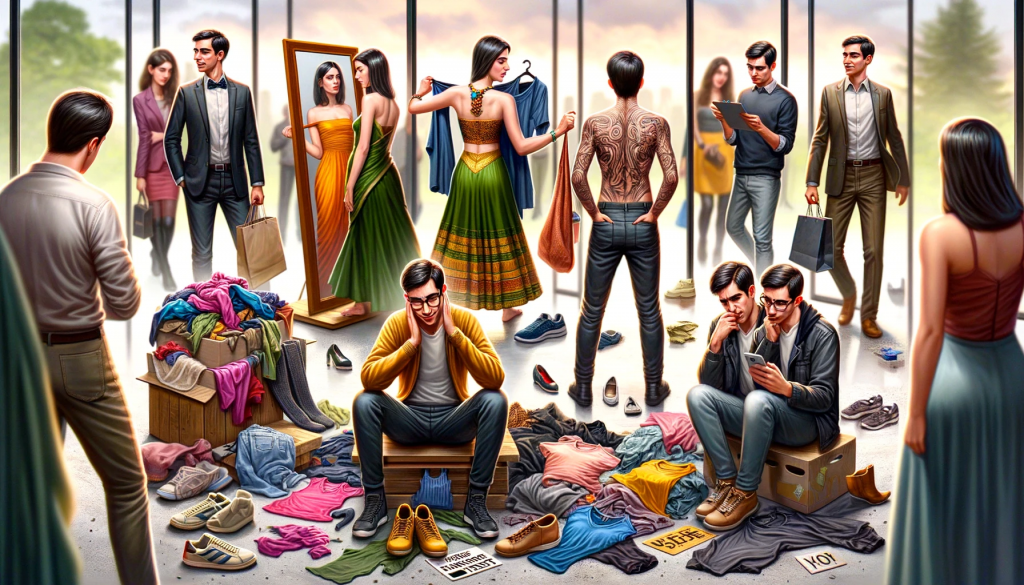
Expressing oneself through clothing has several pros and cons. It’s a topic that touches on individual identity, societal norms, and even psychological aspects. Here’s an overview: Pros of Expressing Oneself with Clothing Personal Identity and Self-Expression: Clothing can be a powerful medium for expressing one’s personality, beliefs, and preferences. It allows individuals to showcase their unique style and stand out in a crowd. Cultural Representation: Clothes can be a way to represent one’s cultural heritage, enabling individuals to celebrate and share their cultural background with others. Boosting Confidence: Wearing clothes that make one feel good can significantly boost self-esteem and confidence. It can also influence how others perceive us, often positively. Artistic Outlet: Fashion can be seen as a form of art. Choosing and combining different pieces allows for creative expression, much like painting or writing. Non-Verbal Communication: Clothing can communicate messages about our status, profession, emotions, and more, without saying a word. Cons of Expressing Oneself with Clothing Judgment and Stereotyping: Unfortunately, people may be judged or stereotyped based on their clothing choices. This can lead to misunderstandings or unfair treatment in professional and social settings. Pressure to Conform: Societal or peer pressure can influence individuals to dress in certain ways to fit in, sometimes at the expense of their own comfort or identity. Cost Factor: Keeping up with fashion trends or buying specific brands can be expensive. This can lead to financial strain or create social divides based on what one can afford. Environmental Impact: The fashion industry has a significant environmental impact, including waste and pollution. Fast fashion, in particular, contributes to this issue. Body Image Issues: Fashion and clothing trends can sometimes promote unrealistic body standards, leading to body image issues and negative self-perception. In conclusion, while clothing is a fantastic medium for self-expression and can have positive psychological effects, it’s also subject to societal judgments and environmental concerns. The key might lie in finding a balance between expressing oneself authentically and being mindful of the broader implications of our clothing choices.
What are the impacts when parents „fashionize“ their children?

The phenomenon of parents „fashionizing“ their children, which refers to dressing them in trendy, stylish, or adult-like fashion, can have various social impacts: 1. Increased Focus on Appearance: It can cultivate an early focus on appearance and aesthetics in children. This might lead to them prioritizing looks over other qualities or aspects of life as they grow older. 2. Social Status and Consumerism: This trend can reflect and reinforce social status and consumerism. Children might learn to associate self-worth with brand names and fashion trends, potentially fostering materialistic values. 3. Peer Pressure and Inequality: It can contribute to peer pressure among children in schools and social settings. Those unable to afford or access similar fashion may feel excluded or inferior, exacerbating feelings of inequality. 4. Early Maturation: Dressing children in adult-like fashion can contribute to the premature maturation of their self-image and behavior, potentially leading to challenges in age-appropriate development and identity formation. 5. Online Presence and Privacy: Parents sharing their fashionably dressed children on social media might inadvertently compromise the child’s privacy and expose them to the public eye, which raises concerns about consent and the digital footprint. 6. Gender Stereotyping: Fashion choices can sometimes reinforce traditional gender stereotypes, limiting children’s exploration of their identity and interests that fall outside these norms. 7. Parental Influence and Autonomy: This trend might also reflect more about the parents‘ preferences and desires, possibly overshadowing the child’s autonomy in choosing their own clothes and developing their personal style. 8. Creativity and Expression: On a positive note, fashion can be a form of expression and creativity. When balanced, it can help children develop a sense of style and self-expression. 9. Economic Impact: There’s also an economic aspect, as this trend can drive market demand in the children’s fashion industry, influencing trends and prices. 10. Environmental Impact: Finally, the fast-fashion aspect tied to constantly changing trends can have environmental consequences, contributing to waste and unsustainable practices. It’s important for parents to find a balance, ensuring that fashion choices for children are age-appropriate, comfortable, and in line with fostering a healthy development of self-esteem and identity.
„How to care for your hair“

Caring for your hair involves several steps and practices to ensure its health and vitality. Here are some general tips: 1. Choose the Right Shampoo and Conditioner: Select products suited to your hair type. For example, if you have dry hair, look for moisturizing products, and if you have oily hair, choose a clarifying shampoo. 2. Washing Frequency: Wash your hair as per your hair type and lifestyle. People with dry hair may need to wash less frequently than those with oily hair. 3. Use Lukewarm Water: Hot water can strip natural oils from your scalp, leading to dryness. Use lukewarm water instead. 4. Be Gentle While Washing: Massage your scalp gently with your fingertips and avoid scrubbing vigorously. 5. Condition Properly: Apply conditioner mainly to the ends of your hair, where it’s needed the most. Avoid the scalp to prevent greasiness. 6. Avoid Excessive Heat Styling: Heat styling tools can damage your hair. Use them sparingly and always apply a heat protectant before styling. 7. Trim Regularly: Regular trims help prevent split ends and keep your hair looking healthy. 8. Eat a Balanced Diet: A diet rich in vitamins, minerals, and proteins can significantly improve hair health. 9. Stay Hydrated: Drinking enough water is essential for maintaining healthy hair. 10. Avoid Tight Hairstyles: Tight ponytails, braids, and buns can cause hair breakage. Opt for looser styles to reduce stress on your hair. 11. Protect Your Hair from the Sun: UV rays can be damaging to your hair. Wear hats or use hair products with UV protection when you’re out in the sun. 12. Be Mindful of Hair Treatments: Chemical treatments like coloring, straightening, or perming can damage your hair. Limit these treatments and ensure they’re done by a professional. Remember, each person’s hair is unique, so it’s important to find a routine that works best for your specific hair type and concerns. If you’re experiencing significant issues with your hair, it’s advisable to consult a dermatologist or a trichologist.
Jeremy Fragrance – Who is he?

Jeremy Fragrance, a prominent figure in the fragrance community, is known for his enthusiasm and passion for perfumes and colognes. His work primarily revolves around reviewing and promoting various fragrances, often through his social media channels and YouTube. Personality 1. Charismatic and Energetic: Jeremy is often noted for his vibrant energy and charismatic presence in his videos. He brings a unique enthusiasm to his fragrance reviews, which has garnered him a significant following. 2. Confident and Persuasive: His confident demeanor, combined with an evident passion for fragrances, makes him a persuasive figure. He often influences his audience’s choices in perfumes and colognes. 3. Engaging and Approachable: Jeremy’s style of communication is direct and engaging, making him relatable and approachable to his audience. He often interacts with his followers, responding to comments and questions. Work 1. Fragrance Reviews: Jeremy’s primary work involves reviewing various fragrances, from well-known brands to niche perfumes. He provides detailed insights into the scent profiles, longevity, and suitability of different fragrances. 2. Brand Collaborations and Promotion: He often collaborates with fragrance brands for promotions. His influence in the fragrance community makes him a valuable partner for brands looking to market their products. 3. Educational Content: Beyond reviews, Jeremy often creates educational content about fragrances. This includes advice on choosing fragrances, understanding scent notes, and the science behind how fragrances are made. 4. Personal Fragrance Line: Expanding his work in the fragrance industry, Jeremy has also ventured into creating his own line of fragrances. This move showcases his deep involvement and commitment to the world of perfumery. Jeremy Fragrance’s contribution to the fragrance community is significant, both in terms of educating the public about various scents and in influencing fragrance trends. His unique blend of charisma, expertise, and a genuine love for perfumes makes him a standout personality in this niche industry. Criticism Jeremy Fragrance, like many public figures, has faced criticism and scrutiny regarding his personality and approach, particularly in the context of his fragrance reviews and public persona. It’s important to consider these criticisms in a balanced way, understanding that public figures often have both supporters and detractors. Here are some common points of criticism: 1. Over-the-Top Enthusiasm: Some viewers find Jeremy’s energetic and enthusiastic demeanor to be excessive or inauthentic. His high-energy style, while appealing to many, can be perceived as overwhelming or overly dramatized by others. 2. Sales-Driven Approach: There are concerns that some of his content may be more commercially driven, especially when he promotes certain brands or products. Critics argue that this could potentially compromise the impartiality of his reviews, leading to questions about the genuineness of his recommendations. 3. Personality vs. Expertise: While his charismatic personality has attracted a large audience, some critics feel that it overshadows the actual content of his fragrance knowledge. They argue that the focus on personality-driven content might detract from more in-depth, informative discussions about fragrances. 4. Repetitiveness and Simplification: Some fragrance enthusiasts critique his reviews for being somewhat repetitive and not diving deeply enough into the complex nuances of scent profiles and composition. They suggest that this simplification might not fully do justice to the intricate art of perfumery. 5. Interactions and Responses: The way Jeremy interacts with his audience and responds to criticism has also been a point of contention. Some viewers feel that he may not always address criticism constructively, which could affect how his audience perceives his openness to feedback and different opinions. 6. Market Influence: His significant influence in the market is a double-edged sword. While it’s a testament to his success, it also raises concerns about the impact he can have on fragrance trends and consumer choices, potentially overshadowing lesser-known or niche brands. It’s important to note that public figures, especially those in subjective fields like fragrance, often face diverse opinions about their work and persona. Criticism, whether constructive or not, is an inevitable part of being in the public eye. For viewers and consumers, it’s always beneficial to approach such content with a discerning eye and consider multiple sources and perspectives. Success Jeremy Fragrance has achieved significant success in the fragrance industry, particularly as a digital influencer and content creator. His success can be measured in various ways: 1. Social Media Presence and Following: Jeremy has amassed a substantial following on social media platforms, especially on YouTube, where he is one of the most popular fragrance reviewers. His channel has garnered millions of views, and his subscriber count is indicative of his widespread influence and popularity. 2. Brand Collaborations and Sponsorships: His success in the industry has led to numerous collaborations and sponsorships with major fragrance brands. These partnerships not only demonstrate his market influence but also contribute to his financial success. 3. Launch of His Own Fragrance Line: Jeremy expanded his repertoire by launching his own line of fragrances. This venture into creating and marketing his own products is a significant marker of success, reflecting both his entrepreneurial spirit and his deep engagement with the fragrance industry. 4. Awards and Recognition: He has received accolades and awards within the fragrance community, further solidifying his status as a key influencer in the field. 5. Global Reach: Jeremy’s content reaches a global audience, which is a testament to his ability to appeal to a diverse and international viewership. This wide reach is crucial for success in the increasingly globalized world of beauty and fragrance. 6. Impact on Sales and Trends: His recommendations and reviews have been known to significantly influence consumer choices and even impact sales of certain fragrances. This level of influence is a strong indicator of success in the digital influencer space. 7. Media Features: Jeremy has been featured in various media outlets, which not only enhances his visibility but also acknowledges his role as a prominent figure in the fragrance industry. Overall, Jeremy Fragrance’s success is multifaceted, encompassing his influence as a content creator, his entrepreneurial ventures, and his impact on the fragrance industry. His ability to engage a large audience and influence consumer behavior places him among the more successful figures in the digital space
Leonardo DiCaprio – Most skilled actor?
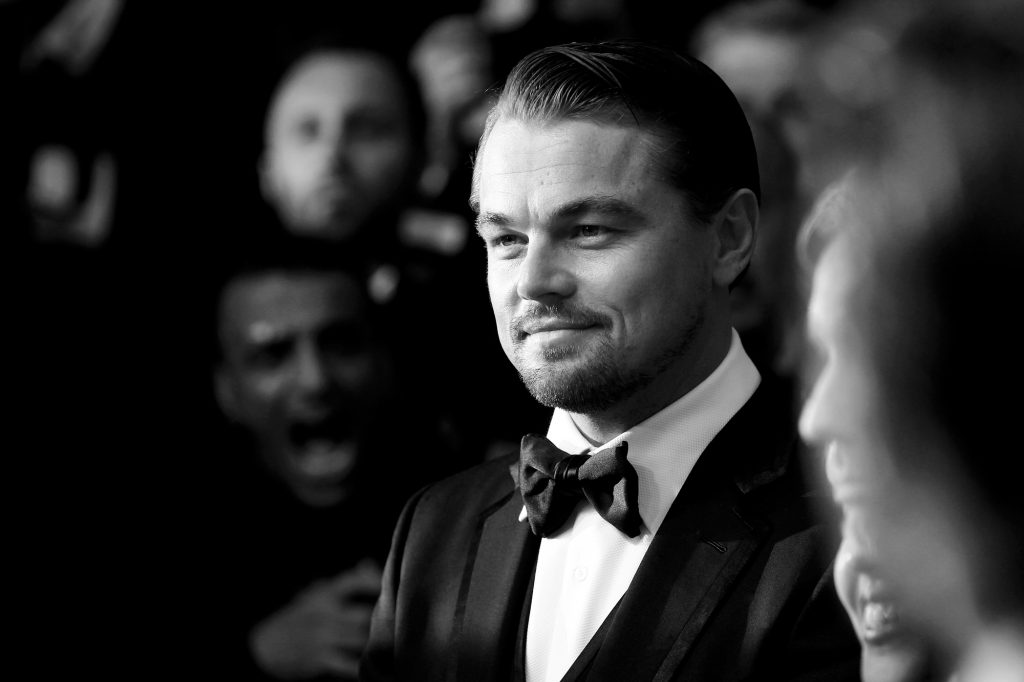
Leonardo DiCaprio is often regarded as one of the most skilled actors of his generation for several reasons: 1. Versatility: DiCaprio has demonstrated a remarkable ability to portray a wide range of characters, from historical figures like Howard Hughes in „The Aviator“ to fictional characters like Jack Dawson in „Titanic“. His roles span various genres, including drama, romance, and action. 2. Commitment to Roles: DiCaprio is known for his intense dedication to his roles. For „The Revenant“, he endured extreme weather conditions and learned to shoot a musket, build a fire, and speak two Native American languages. This level of commitment shows his dedication to authenticity in his performances. 3. Emotional Depth: DiCaprio has a talent for conveying complex emotions and bringing depth to his characters. His performances often include subtle nuances that add layers to his characters, making them more relatable and human. 4. Collaboration with Renowned Directors: DiCaprio has worked with some of the most acclaimed directors in the industry, including Martin Scorsese, Christopher Nolan, and Quentin Tarantino. These collaborations have not only resulted in critically acclaimed films but have also helped DiCaprio hone his craft. 5. Critical Acclaim and Awards: Over his career, DiCaprio has received numerous awards and nominations, including an Oscar for Best Actor for „The Revenant“. His consistent recognition by peers and critics alike is a testament to his skill and impact as an actor. 6. Box Office Success: DiCaprio’s films have enjoyed significant commercial success. This not only reflects his popularity among audiences but also his ability to select and excel in roles that have widespread appeal. 7. Influence and Legacy: DiCaprio has had a significant impact on the film industry and popular culture. His performances have influenced both his contemporaries and younger actors, and his work continues to be celebrated and studied. In summary, Leonardo DiCaprio’s versatility, commitment, emotional depth, successful collaborations, critical acclaim, box office success, and lasting influence on the film industry are key factors that contribute to his standing as one of the most skilled actors of his time.
The Intersection of cinematic movies and the art of filmmaking

The intersection of cinematic movies and the art of filmmaking is a rich and complex topic, blending the technical, artistic, and cultural aspects of cinema. This discussion can be broken down into several key areas: 1. The Evolution of Cinematic Techniques: The art of making films has evolved significantly since the inception of cinema. Early films were limited by technology, focusing primarily on simple shots and linear storytelling. As technology advanced, so did the techniques, including the use of color, sound, and special effects. This evolution has allowed filmmakers to create more complex and visually stunning works, expanding the boundaries of storytelling. 2. Storytelling and Narrative Structure: At its core, cinema is a medium for storytelling. The art of filmmaking involves crafting narratives that engage and resonate with audiences. This includes the development of characters, plot, and setting, as well as the use of narrative devices like flashbacks, nonlinear storytelling, and voiceovers. Great films often combine these elements in innovative ways, pushing the envelope of traditional narratives. 3. Cinematography and Visual Language: Cinematography is a crucial aspect of filmmaking, involving the manipulation of lighting, camera angles, and movement to create visual storytelling. The choice of shots and how they are composed and sequenced can greatly influence the viewer’s experience and interpretation of the film. The art of cinematography is in how these visual elements are used to support the narrative and evoke emotions. 4. Sound and Music in Film: Sound design and music are integral to the cinematic experience. They set the tone, enhance the mood, and can even become a character in their own right. The art of using sound and music effectively in films is a key component of the filmmaker’s toolkit, adding depth and dimension to the visual images. 5. The Role of Directors and Filmmakers: Directors and filmmakers are the visionaries behind films, orchestrating the various elements of production to bring their unique vision to life. Their role involves not just technical knowledge, but also a deep understanding of storytelling, acting, and the collaborative nature of filmmaking. The most celebrated directors are those who have a distinct style and voice, contributing significantly to the art form. 6. Cultural and Social Impact of Films: Films do not exist in a vacuum; they are a reflection of the societies and cultures they emerge from. They can influence public opinion, highlight social issues, and even shape cultural norms. The art of filmmaking, therefore, carries a responsibility to not only entertain but also to enlighten and provoke thought. 7. The Future of Filmmaking: With the advent of digital technologies, virtual reality, and AI, the future of filmmaking is ripe with possibilities. These technologies are transforming how films are made and experienced, offering new avenues for storytelling and creativity. As the line between traditional cinema and new media blurs, the art of filmmaking continues to evolve in exciting directions. In conclusion, the collision of cinematic movies with the art of making films is a dynamic and ever-evolving landscape. It combines a range of disciplines and skills, from storytelling and visual artistry to technical expertise and cultural insight. This fusion is what makes cinema such a powerful and enduring form of art and entertainment.
H&M Announces Expansion into Brazil
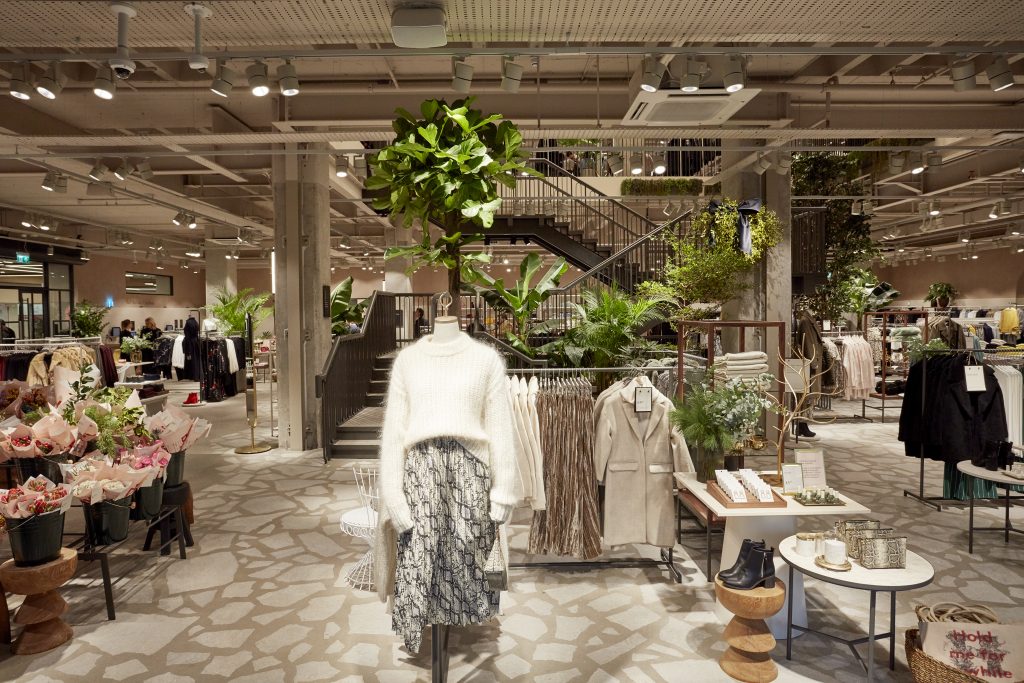
H&M has revealed plans to establish its presence in Brazil with the launch of both physical stores and an online platform in 2025. This move marks a significant step in H&M’s ongoing expansion throughout Latin America. The strategy involves initially targeting key cities in Southeast Brazil, with ambitions to gradually extend its reach nationwide. Since opening its first Latin American store in Mexico in 2012, H&M has successfully penetrated markets in Peru, Uruguay, Chile, Colombia, Ecuador, Guatemala, Panama, and Costa Rica. Brazil, with its population exceeding 210 million and a notable passion for fashion, presents a substantial opportunity for H&M to grow its market share. Statement from Helena Helmersson, CEO of H&M Group Helena Helmersson, CEO of H&M Group, expressed excitement about the venture: „Launching in Brazil in 2025 marks an exhilarating phase in our Latin American journey. We’ve seen positive growth in this region and believe Brazil holds immense promise. We’re eager to introduce Brazilian customers to H&M’s ethos of blending fashion, quality, and sustainability with affordability.“ Partnership with Dorben Group To facilitate this expansion, H&M is collaborating with the Dorben Group, leveraging their deep understanding and expertise in the local market. “It is an honour and a privilege for us to enter into this partnership with H&M in Brazil, thereby strengthening our existing relationship with a leader in the fashion industry. This collaboration will enable both companies to leverage their unique strengths, resources, and expertise to unlock the incredible potential of the Brazilian market,” comments Mehdi Beneddine, President of Dorben Group.
The Evolution of Lifestyle: A Decade of Change
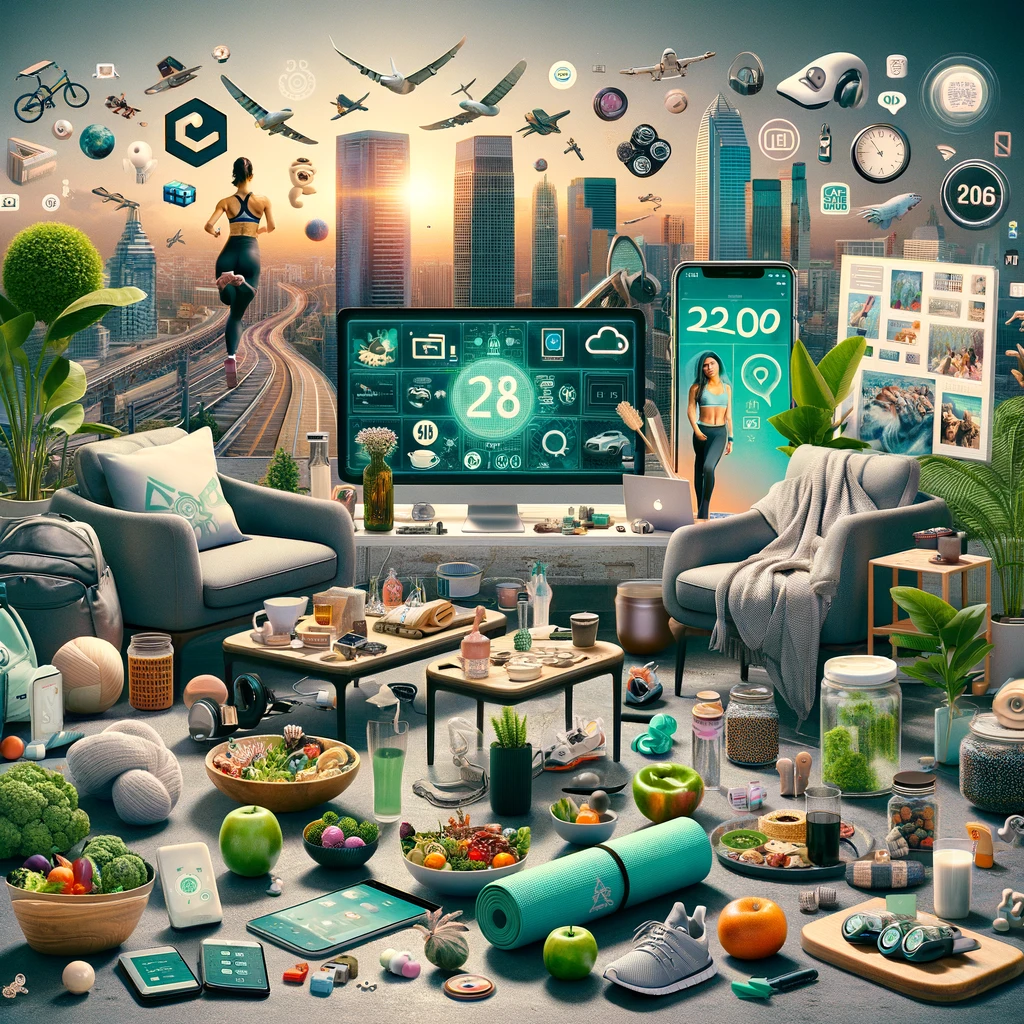
Over the past decade, the global lifestyle landscape has undergone a profound transformation, marked by significant shifts in consumer behavior, technology, and cultural norms. This article explores the key lifestyle changes that have shaped our lives from 2014 to 2024, drawing insights from various sources. 1. The Rise of Digital Dominance Ten years ago, the digital revolution was just picking up speed. Today, it has engulfed every aspect of our lives. According to a report by Pew Research Center, internet usage among adults has increased from 74% in 2014 to nearly 90% in 2024. Smartphones, once a luxury, are now ubiquitous, fundamentally altering how we communicate, work, and entertain ourselves. 2. The Wellness Wave The last decade has seen a dramatic shift towards health and wellness. A survey by the Global Wellness Institute shows that the wellness industry grew by 6.4% annually from 2015 to 2020, outpacing global economic growth. This surge is attributed to a growing awareness of mental health, physical fitness, and nutrition. 3. The Green Revolution Environmental awareness has been one of the most significant changes. A study by Nielsen in 2020 revealed that 73% of consumers would change their consumption habits to reduce their environmental impact. This shift has led to the rise of sustainable products, eco-friendly practices, and a focus on renewable energy sources. 4. The Gig Economy and Remote Work The gig economy has exploded over the past decade. A report by McKinsey Global Institute estimated that up to 162 million people in Europe and the United States were engaged in some form of independent work by 2021. The COVID-19 pandemic accelerated this trend, making remote work a new normal for many. 5. The Social Media Influence Social media has reshaped our social interactions and consumption patterns. According to Statista, the number of social media users worldwide has surged from 2.07 billion in 2014 to over 4 billion in 2024. Platforms like Instagram, TikTok, and Facebook have become primary sources of news, entertainment, and social connection. 6. The Rise of Plant-Based Diets There’s been a notable shift in dietary habits, particularly towards plant-based diets. The Vegan Society reports that the number of vegans in the UK quadrupled between 2014 and 2019. This trend is driven by health concerns, environmental factors, and ethical considerations about animal welfare. 7. The Sharing Economy The sharing economy has redefined ownership and access. Companies like Airbnb and Uber have become household names, emphasizing access over ownership. A study by PwC predicted that the sharing economy’s global revenues would reach $335 billion by 2025, a steep increase from $15 billion in 2014. 8. The Personalization Trend Advancements in technology have made personalization a key trend. From personalized marketing to customized health plans, consumers now expect products and services tailored to their preferences. A report by Epsilon indicates that 80% of consumers are more likely to purchase from a brand that provides personalized experiences. 9. The Fitness and Athleisure Boom The fitness industry has seen exponential growth, coupled with the rise of athleisure wear. According to a report by Allied Market Research, the global athleisure market was valued at $155.2 billion in 2018 and is projected to reach $257.1 billion by 2026. 10. The Focus on Mental Health Finally, the last decade has brought mental health into the spotlight. The World Health Organization has emphasized the importance of mental well-being, leading to increased investment in mental health services and a destigmatization of mental health issues. In conclusion, the last decade has been marked by substantial changes in how we live, driven by technological advancements, environmental concerns, and a shift in societal values. These changes reflect a global population that is more connected, health-conscious, and environmentally aware than ever before.
Upcoming Lifestyle Trends in 2024
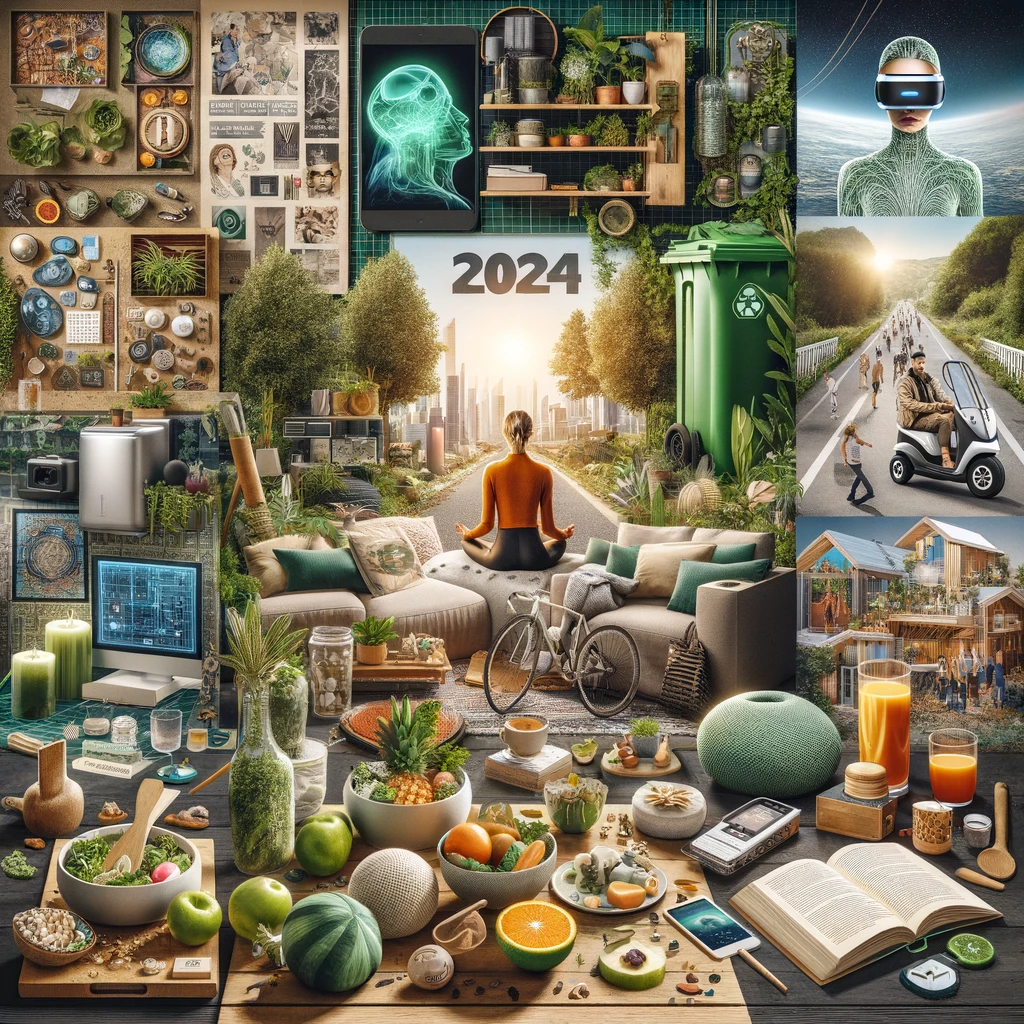
As we approach 2024, the world of lifestyle and culture is buzzing with new trends that are set to redefine how we live, work, and interact. From the rise of sustainable living to the evolution of digital integration in our daily lives, the upcoming trends are not just about fashion or technology; they’re about a shift in mindset and values. Let’s dive into what 2024 has in store for us. 1. Eco-Conscious Living Sustainability isn’t just a buzzword anymore; it’s becoming a way of life. In 2024, we expect to see a significant shift towards more eco-friendly choices in our everyday lives. This includes everything from zero-waste lifestyles, choosing sustainable fashion, and even eco-friendly travel options. Brands that fail to align with these values might find themselves struggling to keep up. 2. Mindfulness and Mental Wellness The past few years have put a spotlight on the importance of mental health. In 2024, mindfulness practices like meditation, yoga, and digital detoxes are expected to become even more mainstream. Apps and platforms offering mental wellness services will proliferate, making self-care more accessible than ever. 3. The Rise of the Homebody Economy The concept of staying in is the new going out continues to gain traction. With more people working from home, there’s a growing market for products and services that enhance the at-home experience – be it home gyms, kitchen gadgets, or entertainment systems. This trend also leads to a boom in home delivery services across various sectors. 4. Virtual Reality Escapes As technology continues to advance, so does the world of virtual reality. In 2024, we expect to see VR being used not just for gaming but as a form of escapism. Virtual travel, VR meditation apps, and even virtual social gatherings are likely to become more popular, offering new ways to relax and connect. 5. Plant-Based Diets The shift towards plant-based diets is more than a trend; it’s a movement. In 2024, expect to see even more options for plant-based eating, both in supermarkets and restaurants. This trend is driven by a growing awareness of health benefits, environmental concerns, and animal welfare. 6. Smart Homes and AI Integration Smart home technology is becoming more sophisticated, and by 2024, AI integration in homes will be more seamless. From voice-activated appliances to smart security systems, the focus will be on making life more convenient and efficient. 7. A Return to Craftsmanship In a world increasingly dominated by mass production, there’s a growing appreciation for artisanal and handcrafted products. Whether it’s furniture, clothing, or everyday items, the demand for unique, quality pieces with a story behind them is on the rise. 8. Experiential Travel Travel in 2024 will be about unique experiences rather than just destinations. Travelers are seeking immersive cultural experiences, adventure travel, and opportunities for personal growth. This trend also includes a focus on sustainable and responsible travel practices. 9. Digital Detoxes With our lives becoming increasingly digitized, the need for digital detoxes is more pronounced. In 2024, expect to see more people taking regular breaks from technology to reconnect with the physical world and enhance their mental well-being. 10. Fashion for Expression Fashion in 2024 will continue to be a means of self-expression. However, there will be a stronger emphasis on individuality and sustainable practices. Upcycling, thrifting, and sustainable fabrics will dominate the fashion scene, moving away from fast fashion. As we move into 2024, these lifestyle trends reflect a global shift towards sustainability, mental wellness, and a more mindful approach to technology. It’s an exciting time, with new innovations and ideas shaping our daily lives in positive ways.
